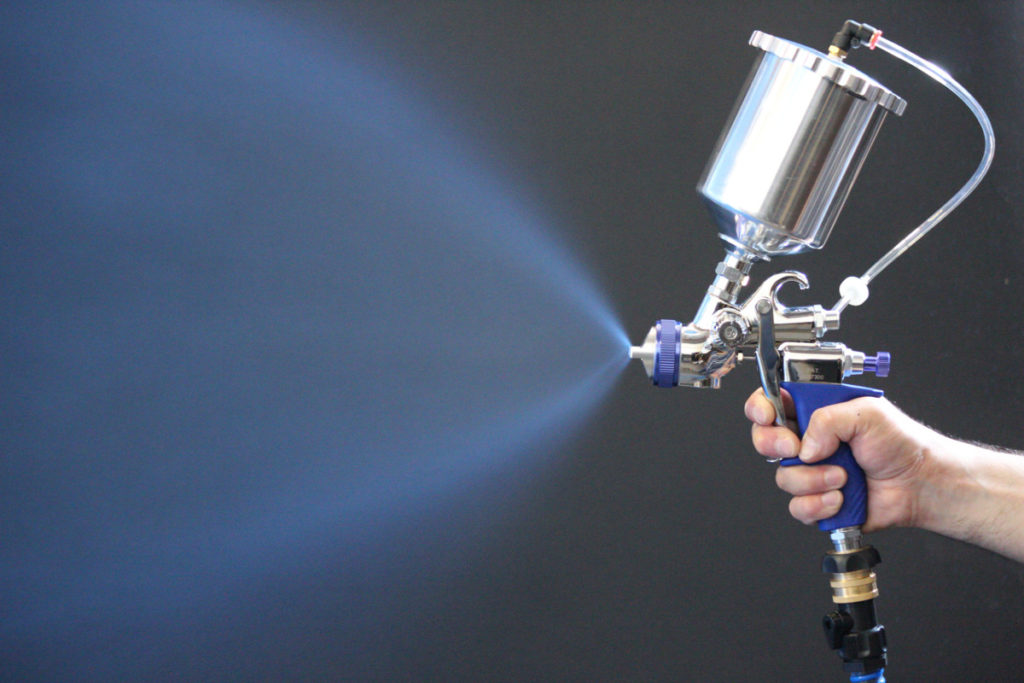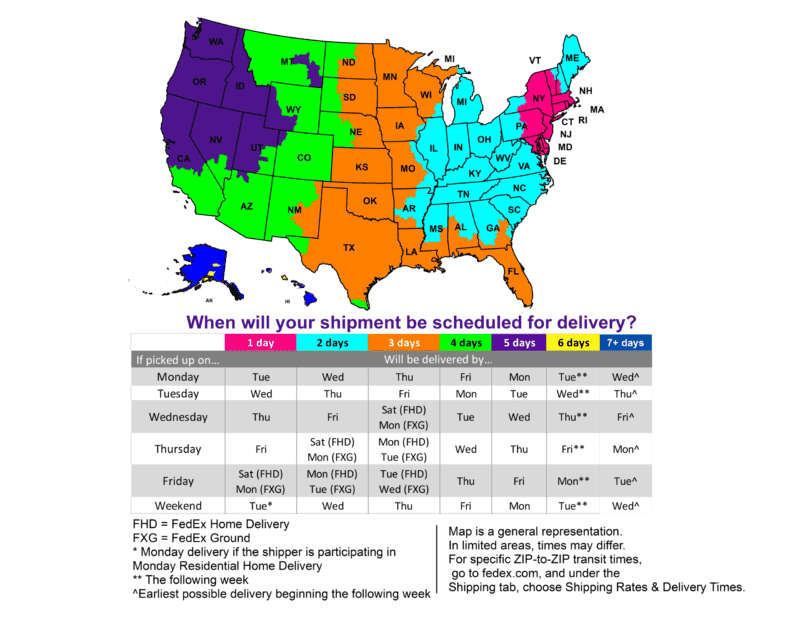Thanks to Larry H., Frank, Glen J., Corey, and Aaron H., for your comments on Marty’s tip about compressed air spray guns.
Today, I’d like to tell you about my favorite turbine spray gun.
It’s the Fuji T75G Turbine Gravity HVLP Spray Gun.
UPDATE: You can get the FREE Fuji Spray gun of your choice — including the T75G — during the June 2021. Click here for all the details.
What I find most intriguing about the Fuji T75G Turbine Gravity HVLP Spray Gun is it’s balance in-hand and overall lightness.
Even with a 600cc gravity cup filled with our Emtech HSF5000 Primer, the gun did not feel top heavy. This balance produced less hand and forearm fatigue after six hours of testing in my lab.
And when I took this gun apart to inspect its construction I found the fluid passage and all of the internal components to be sturdy and well made.
In short, the T75G is easy to use, sturdy, and gets great results.
Configured with a 1.3mm air cap, the T75G (“G” for gravity-fed) handles our Emtech water based clear coats with great atomization quality thanks to the pressurized gravity cup design.
Fitted with an ergonomically-friendly fan pattern control knob — the fan size is adjustable from narrow to a full 10″ and is fully incremental.
The Fuji T75G is a non-bleed gun. This means that air passes through the spray gun only when the trigger is pulled. The key benefit of non-bleed design is the elimination of atomization air prematurely drying the wet film while it is still in its early leveling stage.
Less air turbulence in the spray area also means less possibility of ambient contamination finding its way onto your newly applied wet finish.
A non-bleed design is a must-have feature for modern turbine-driven guns, and Fuji has gotten this feature right in the T75G design.
Hope that helps explain why this is my go-to turbine spray gun. What’s your favorite?
Please share your thoughts or read what others are saying below in the comments section.



Hi, I’ve been using a Fuji 4 stage quiet unit for at least 12 years. It’s held up very well. I bought their gravity fed gun about 5 years ago and like it except it’s a sidewinder which is fine with a small cup but hard on the wrist with a larger cup. Fuji had a teflon coated 32 oz. cup for their siphon gun which came with the unit. I was hoping to get a teflon coated cup for the gravity fed gun but as far as I know they haven’t offered one. I’m using 3M PPS which works very well, the liners can be used many times so that helps with cost. Are you using something similar or has Fuji offered a teflon cup? I will say that the first years I used Target Coatings were a lot of hit and miss as far as results go. I have had very good results in the last few years with the conversion varnish, and the acrylic lacquer.
Stephen – Thank you for the good questions. I will check with Fuji to see what their status is for a new cup assemblies for your gun. Are you using the GX or T75?
Also, the PPS system is very user-friendly and it is my go-to for large and small jobs — switching between the Midi and the Min, it depends on the fluid volume I intend to be spraying.
Keep up the good work with our Emtech finishes – once you have them dialed-in you will see great consistency.
-JeffW-
Hey, Stephen, I’m not a huge fan of teflon lined cups, and simply for the reason that the liner could crack if the spray gun drops onto the cement floor of a spray booth. (Not that anything like that has ever happen to me, because I’m so dexterous, right?!). I am, however a huge fan of 3M PPS and use it with my T-Series spray guns as well as the two Fuji Spray compressed-air guns I use most (LX-20 and MP-V8). If you’re impressed by the conversion varnish, then I know you’ll be blown away by the sprayability and performance of the EM2000 alkyd varnish. It’s become my go-to varnish for the furniture pieces I design and make. Marty Schlosser
I’m going to try your EM6000 lacquer product (based on luthier Jay Lichty’s water based lacquer finishing course available on The O’Brien Guitars website) on my next guitar using the husky siphon feed detail spray gun Model# H4910DSG which has a stainless steel needle and tip. I’m still working on the guitar and putting together a spray booth and plumbing in the booth to compressor. So I’m not quite ready to spray but I hope to be before June. I’m building a Martin size 1 parlor guitar (12.5” wide lower bout). Jay uses a similar what the auto industry calls “door jamb” gun and it works for him. (I don’t have a turbine system yet).
Larry, good going on laying the groundwork to properly prepare what sure sounds like will be a great spray finishing environment. While you’re working your booth, ensure you have a properly sized needle set and corresponding aircap for your spray gun, which for EM6000 is 1.3mm – 1.5mm in size. Let us know how things work out! Marty Schlosser
Thanks for the great review. I am new to The Em Target Coatline. As a guitar builder I have been rattle “canning” for years but just got an Earlex 5500. Just getting used to it and working through the learning curve. Always impressed with the Fuji line. It’s great to have you as a resource take care
A general suggestion — A companion article titled “What is a XXXX and why do I want one” would be helpful with these small articles. In this case I have some experience with the older spray technology and with one of the early HVLP guns. I read the article but don’t have the background to appreciate it. This is probably equally true for others reading the earlier spray gun article. A second article titled “10 Tips for getting the most out of your XXXX” would also be appreciated since I’m sure this old dog needs to learn new tricks. In any event I look forward the the next offering.
Glen – Thank you for the reply. We’ll take your suggestion behind closed-doors to review with our Blogger. Stand-by! ;)
-JeffW-
I have a Fuji sprayer. It would be nice to see what air cap you would recommend for each of the products that you sell. I usually guess correct most of the time but it would be great to see what is really the best for the application.
John,
Thank you for your inquiry. Here is a list of Fuji Caps and the Emtech finishes that work best with them.
1.0mm = Thin-bodied stains and sealers such as our NR4000 Stain, USH3000 Shellac and EM1000 Sanding Sealer
1.3mm & 1.4mm = Medium-bodied clear coats such as our EM2000wvx Varnish, EM6000 Production Lacquer, EM7000HBL Lacquer, EM8000cv and EM9300 Polycarbonate Urethane
1.8mm & 2.0mm = HSF5000 Primer Surfacer, EM6500 Pigmented Lacquer Series and EM6600 Raven Black Lacquer
Keep in mind that these are excellent starting points and that you still have room to thin these coatings with basic tap water or SA5 Retarder if you want to reduce the viscosity a bit more to obtain improved atomization during high temperature/low humidity conditions.
Feel free to contact me directly if yo have any further questions.
-JeffW-
Here’s something I’ve wondered about the Fuji setup: The flex line. It’s the thinner, flexible, line about 3 feet long that you can put between the gun and the heavy turbine line. I think there is one in your photo. Between the spiral wind and the drop in diameter, there must be some pressure drop and loss of volume across the flex line compared to connecting the gun directly to the heavier hose. I’ve always wondered if that can ever be enough to matter? For a lot of stuff, I don’t think it would be hard to skip the flex line.
Ed — Thank you for your inquiry.
You ask a very good question. I’ll run this past Jim at Fuji Spray to learn what he has to say about your question.
Perhaps we can have Jim hop-in and answer for us..?
-JeffW-
Hi, Ed, thanks for your astute question. There is, indeed a pressure loss, but given that the hose is only 3 feet long, from a practical perspective it’s almost irrelevant. The only time I recommend removing it is if your turbine has less than 4 stages and are spraying high viscosity finishes (things like pigmented lacquer or latex paint) where maximum air is needed to effectively atomize such finishes.
Again, great question.
Marty